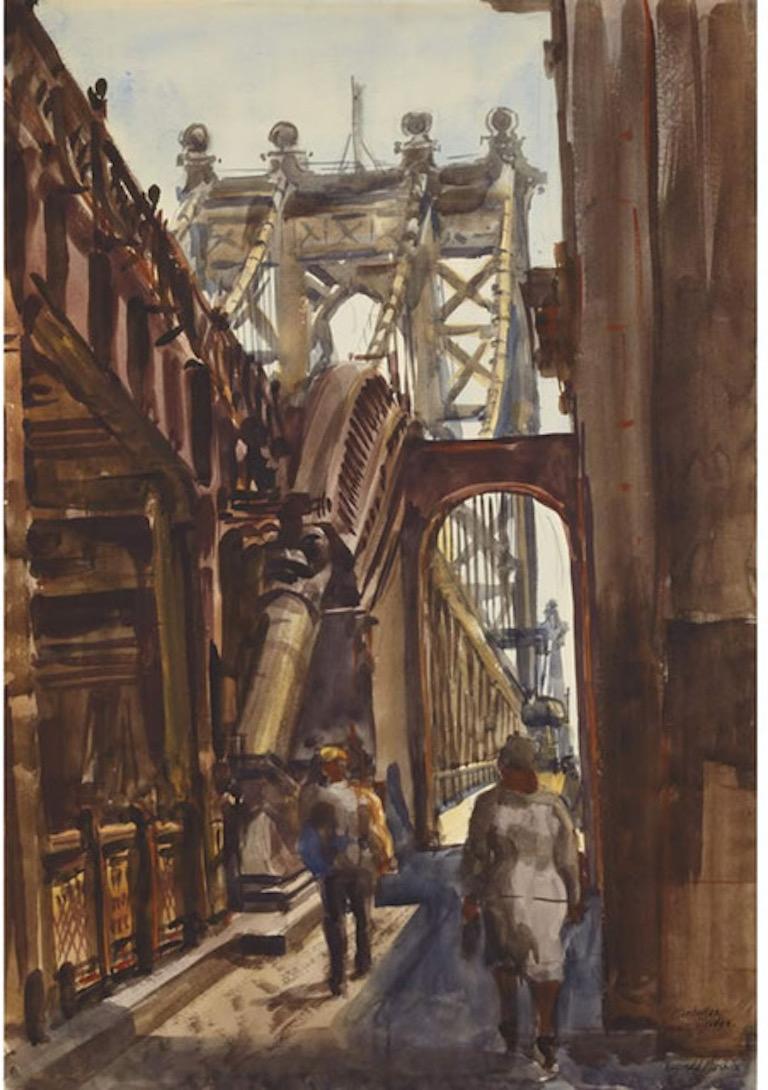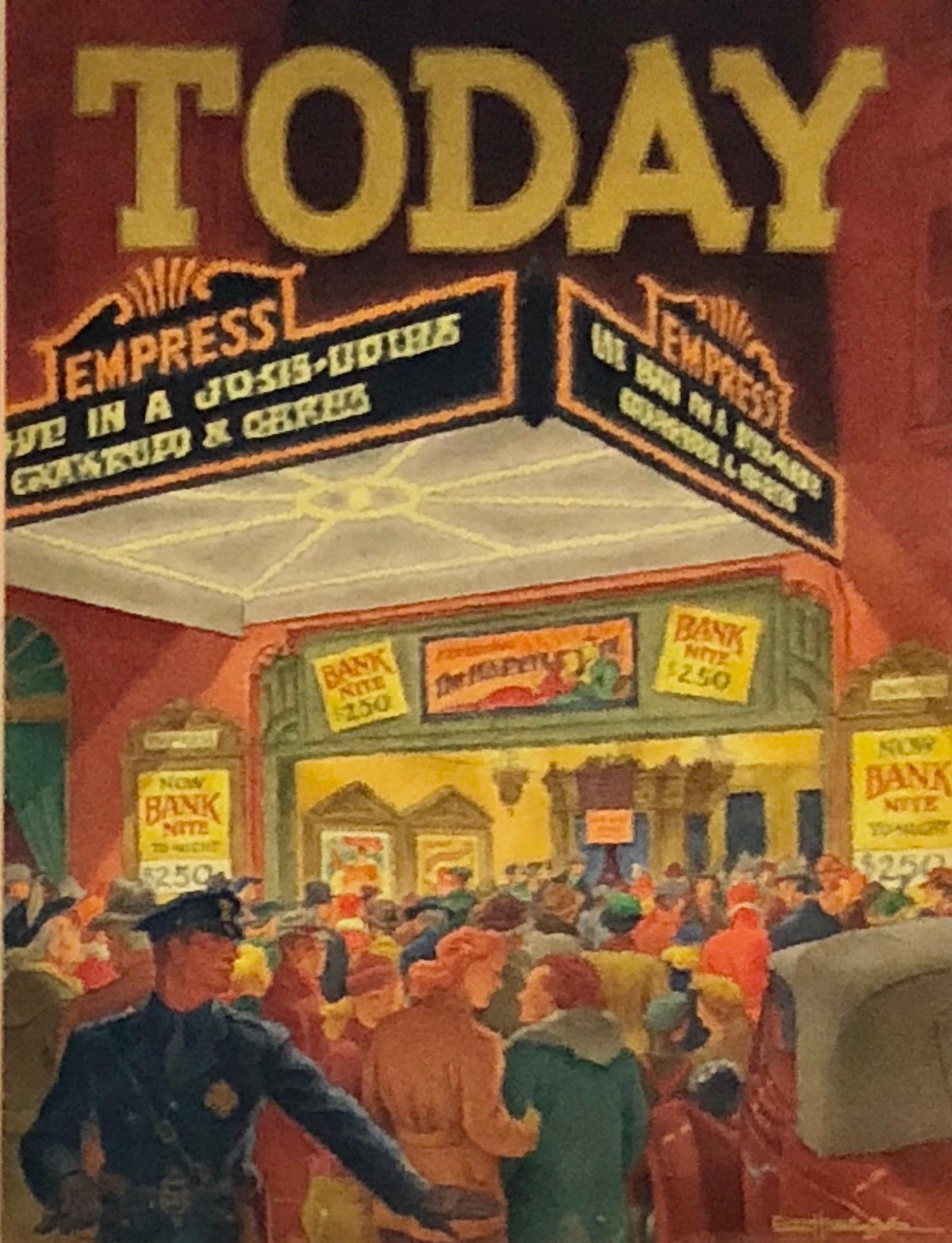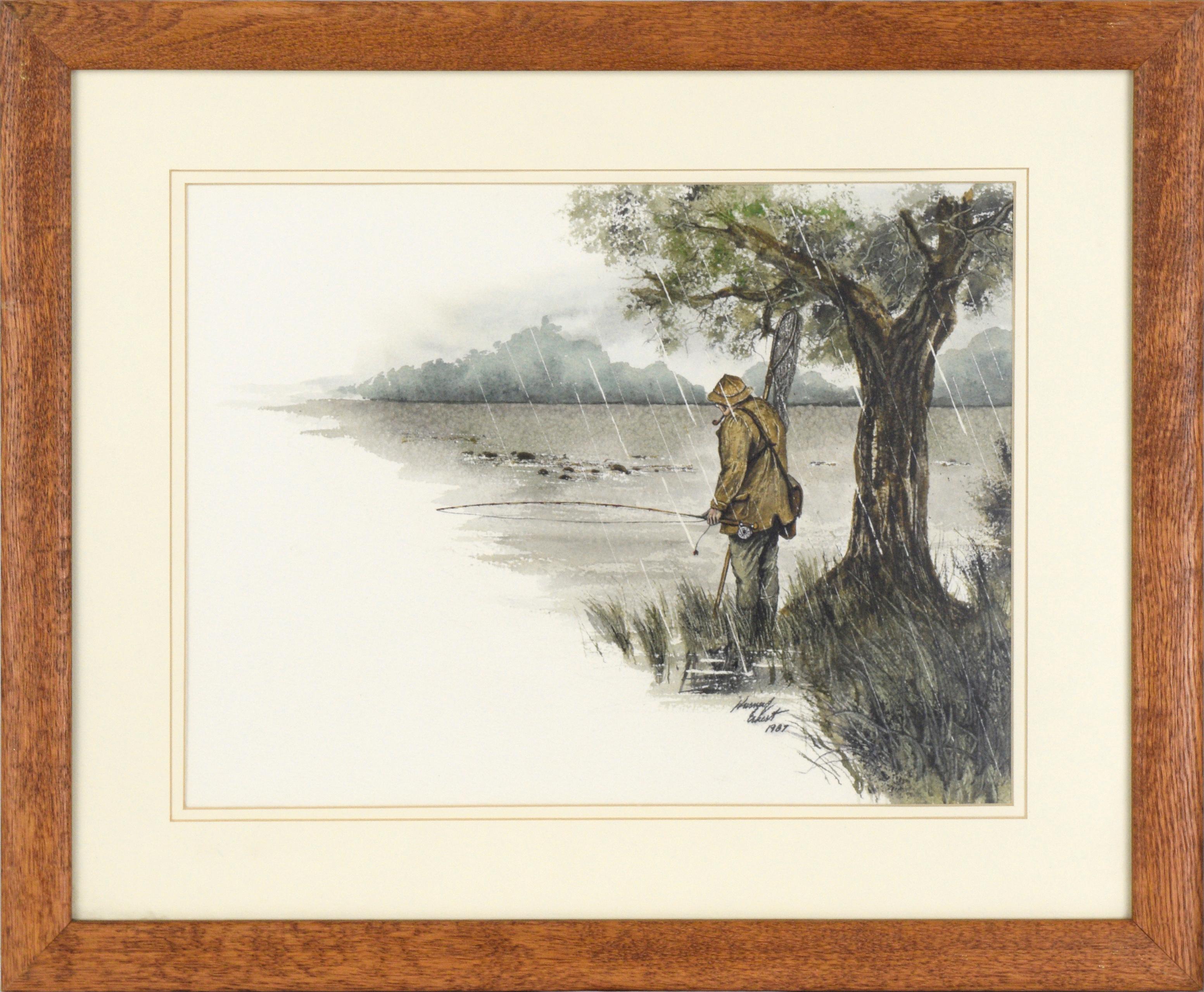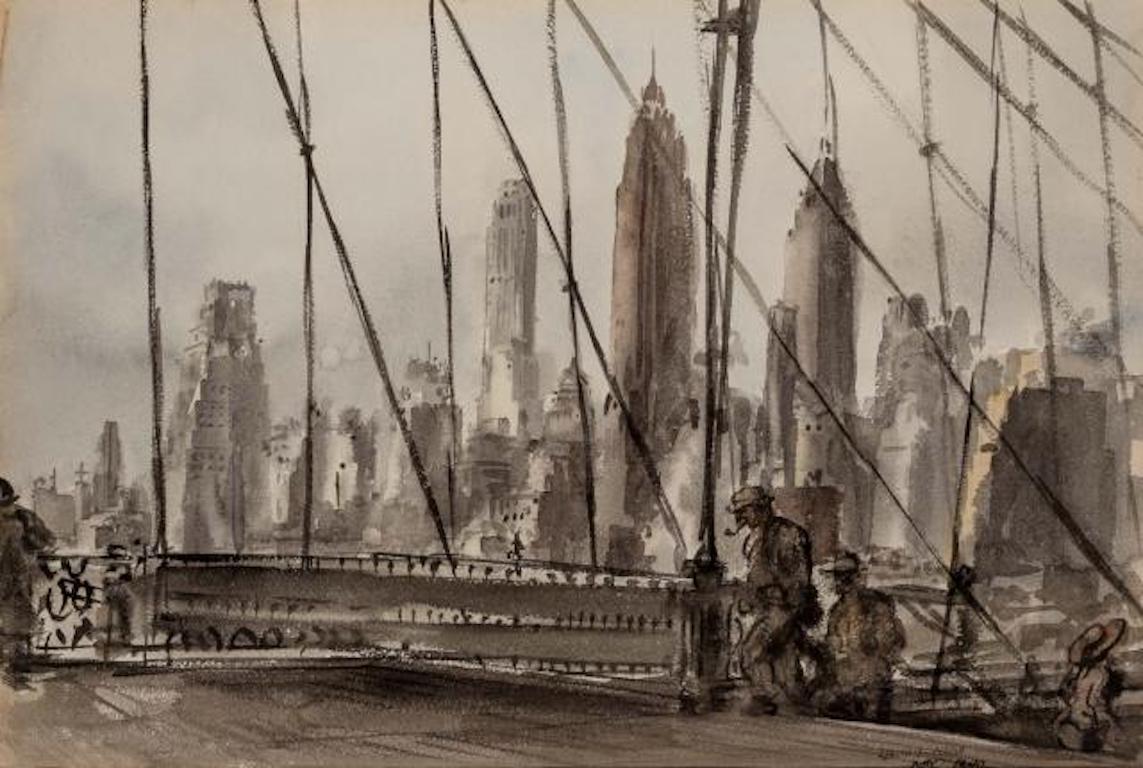Charles Demuth"Bathers" American Scene Social Realism 20th Century Modernism Ashcan Fauvismc. 1930
c. 1930
About the Item
- Creator:Charles Demuth (1883-1935, American)
- Creation Year:c. 1930
- Dimensions:Height: 20 in (50.8 cm)Width: 17 in (43.18 cm)
- Medium:
- Movement & Style:
- Period:
- Condition:
- Gallery Location:New York, NY
- Reference Number:1stDibs: LU1156213569312
Charles Demuth
Acclaimed for his lively Impressionistic watercolors — as well as for his important role in Precisionism, a movement that emphasized geometry and shared commonalities with Cubism and Futurism — American painter Charles Demuth created some of his most recognized works on borrowed time. In the final decade of his life, plagued by ailing health, Demuth painted his renowned Precisionist works like I Saw the Figure 5 in Gold and My Egypt. With each painting, Demuth filled up a life bookended by illness — maladies that both ignited his art career and, ultimately, snuffed it out.
Born in Lancaster, Pennsylvania, Demuth was bedridden at a young age, around four or five, from what would come to be known as Perthes, which affected his mobility and forced him to spend much of his youth at home. Fortunately, his mother provided him with an ample amount of art supplies and nurtured a passion for painting that he sustained over the course of his life.
While Demuth relied on a cane for much of his life, he was well enough to attend Franklin and Marshall College and study art at both Drexel University and the Pennsylvania Academy of the Fine Arts. He completed his first oil self-portrait in 1907 and met the first of what would become a string of influential friends in American artist William Merritt Chase and American painter and arts administrator Thomas Anshutz.
Shifting his focus from oil paintings to watercolors after concluding his studies, Demuth created works that depicted Harlem Renaissance-era jazz clubs and chronicled taboo gay subculture in New York City. The artist was openly gay, and works of this type, even as they were not intended for public exhibition at the time, influenced artists such as Andy Warhol in the decades that followed. His network grew to include artists Alfred Maurer, Patrick Henry Bruce, John Marin and photographer Edward Steichen. American photographer Alfred Stieglitz and modernist painter Georgia O’Keeffe proved to be among the most artistically influential on Demuth. Stieglitz’s famed art gallery in New York, 291, became a spot that the Pennsylvania painter frequented and a location at which he developed an interest in Auguste Rodin’s watercolors and O’Keeffe’s Precisionism.
Demuth also befriended wealthy pharmacist Dr. Albert Barnes in 1905. After the artist received his diabetes diagnosis, a death sentence at the time, Barnes requested Demuth consult with Dr. Frederick Allen, then the leading expert on diabetes in America. Barnes helped with funding Demuth’s insulin treatment — the painter was among the first patients to receive insulin in the United States. Demuth turned largely to painting still lifes of flowers and produce that his mother brought into the house. He died in 1935.
Today, the Barnes Foundation holds the largest collection of Demuth’s artwork. His paintings are also held in the collections of the Philadelphia Museum of Art and the Demuth Museum, which is located in Demuth’s former studio and home and merged with the Lancaster Museum of Art in 2014.
On 1stDibs, find a collection of Charles Demuth drawings and watercolor paintings.
- ShippingRetrieving quote...Ships From: New York, NY
- Return PolicyA return for this item may be initiated within 3 days of delivery.
- "Manhattan Bridge" NYC American Scene Modernism Watercolor WPA Urban RealismBy Reginald MarshLocated in New York, NYReginald Marsh "Manhattan Bridge" NYC American Scene Modernism Watercolor WPA Urban Realism, 20 x 14 inches. Watercolor and pencil on paper, 1938. Signed...Category
1930s American Modern Landscape Drawings and Watercolors
MaterialsPaper, Watercolor, Pencil
- Magazine Cover Illustration Mid 20th Century Modern Theatre Broadway Realism WPABy Ernest Hamlin BakerLocated in New York, NYMagazine Cover Illustration Mid 20th Century Modern Theatre Broadway Realism WPA Ernest Hamlin Baker (1889 – 1975) “Today Magazine” Cover ...Category
1930s American Modern Figurative Drawings and Watercolors
MaterialsGouache, Paper, Watercolor, Ink
- Reginald Marsh "Brooklyn Bridge" NYC Modernism WPA Mid-Century Watercolor ModernBy Reginald MarshLocated in New York, NYReginald Marsh "Brooklyn Bridge" NYC Modernism WPA Mid-Century Watercolor Modern Reginald Marsh (American, 1898-1954) Brooklyn Bridge, 1940, Signed and dated Reginald Marsh May 1940 (lr), Watercolor over traces of pencil on paper , 15 x 22 inches sight. Reginald Marsh was born in Paris, France in 1898, the child of artist parents. He was born over a small cafe on Paris' Left Bank. He was brought to the United States in 1900 and was drawing before he was three. He studied art at Yale University and the Art Students League, during which time he worked primarily as an illustrator for New York newspapers and magazines. After studying in Paris in 1925 and 1926, he turned seriously to painting. In 1929 he was introduced to the egg-tempera medium, which he used extensively the rest of his life. Marsh's gusto for painting the bottom crust of society contrasted curiously with his background. His parents, both well-known artists, were steeped in academic traditions. He attended Lawrenceville Academy and Yale; perhaps this elite background made it possible to paint the earthy people he did with a journalist's objectivity. An admirer of Rubens and Delacroix, he disliked modernist art; indeed, his lifelong preoccupation was with people - enjoying themselves at beaches, at amusement parks, or on crowded city streets. Marsh was a second-generation Ash Can School painter and printmaker, best known as an urban regionalist. He spent his days sketching in small notebooks...Category
1940s American Modern Figurative Drawings and Watercolors
MaterialsPaper, Watercolor
- "Times Square" Mid 20th Century 1937 Modernism Broadway Drawing NYC CityscapeLocated in New York, NY"Times Square" Mid 20th Century 1937 Modernism Broadway Drawing NYC Cityscape Philip Goodwin (20th Century) "Times Square," 23 ½ x 17 ¼ inches. Gouache...Category
1930s American Modern Landscape Drawings and Watercolors
MaterialsGouache, Paper
- "Going to the Festival" WPA Ashcan 20th Century American Scene Modern RealismBy Daniel Ralph CelentanoLocated in New York, NY"Going to the Festival" WPA Ashcan 20th Century American Scene Modern Realism Daniel Celentano (1902 - 1980) "Going to the Festival," 14 1/2 x 10 1/2. Watercolor on paper, c. 1930s....Category
1930s American Realist Figurative Drawings and Watercolors
MaterialsPaper, Watercolor
- TOBACCO ROAD Mid 20th Century Realism 1940 Drawing from the Novel WPA Literary 2By David FredenthalLocated in New York, NYTOBACCO ROAD Mid 20th Century Realism 1940 Drawing from the Novel WPA Literary 2 10 1/2 x 6 (sight), Signed David Fredenthal lower right. Framed by Lowy....Category
1930s American Realist Figurative Drawings and Watercolors
MaterialsPaper, Ink, Watercolor
- Chinese Theater, Los AngelesBy Dong KingmanLocated in Missouri, MODong Kingman "Chinese Theater, Los Angeles" 1965 Watercolor on Paper Sheet Size: 15 x 22 inches Framed Size: approx 19 x 26 inches Dong Kingman, the world-renowned artist and teacher, died in his sleep on May 12, 2000 at age 89 in his home in Manhattan. The cause was pancreatic cancer. Long acknowledged as an American watercolor master, he has received an extraordinary number of awards and honors throughout his 70-year career in the arts. Included are two Guggenheim fellowships in 1942 and 1943; the San Francisco Art Association First Purchase Prize, 1936; Audubon Artist Medal of Honor, 1946; Philadelphia Watercolor Club Joseph Pennel Memorial Medal, 1950; Metropolitan Museum of Art Award, and the National Academy Design 150th Anniversary Gold Medal Award, 1975. In 1987, the American Watercolor Society awarded Dong Kingman its highest honor, the Dolphin Medal, "for having made outstanding contributions to art especially to that of watercolor." His work is represented in the permanent collections of 50 museums and universities, including the Boston Museum of Fine Arts, M.H. deYoung Memorial Museum of Art, the Metropolitan Museum of Art, the Whitney Museum, Museum of Modern Art, Art Institute of Chicago, Pennsylvania Academy of Fine Arts, Sheldon Memorial Art Gallery and Sculpture Garden, Des Moines Art Center, Columbus Museum of Arts and Crafts, Brooklyn Museum and Hirshhorn Museum. Born in Oakland, California in 1911 of Chinese descent, Kingman moved to Hong Kong at age five. He studied art and calligraphy in his formative years at the Lingnan School. The painting master Szeto Wai had recently studied art in Paris and took a keen interest in young Dongs precocious talents. He taught him both Chinese classical and French Impressionist styles of painting. Kingman returned home to Oakland when he was 18 at the height of the Depression. He worked as a newsboy and dishwasher to make ends meet. When he was employed as a houseboy for the Drew family in San Francisco, he painted every spare moment. In a year, he created enough pictures to have a one-man show at the Art Center. It attracted the attention of San Francisco art critics who raved about Kingmans unique style. Wrote Junius Cravens of the San Francisco News: "That young Chinese artist is showing 20 of the freshest and most satisfying watercolors that have been seen hereabouts in many a day Kingman already has developed that universal quality which may place a sincere artist work above the limitations of either racial characteristics or schools. Kingmans art belongs to the world at large today." Dong Kingman became an overnight success. From 1936 to 1941, he was a project artist for WPA and became a pioneer for a new school of painting, the "California Style." His two Guggenheim fellowships enabled him to travel the country painting American scenes. His first one-man show in New York at Midtown Galleries in 1942 was well received in the media, including Time, Newsweek, the New Yorker and American Artist. M.H. de Young Memorial Museum in San Francisco held a major exhibit of his watercolors in 1945. In 1951, Midtown presented a 10-year retrospective of his work. Time Magazine wrote, "At age 40, Kingman is one of the worlds best watercolorists." Other retrospectives, including Corcoran in Washington,D.C. an d Witte Memorial Museum in San Antonio, were held for the artist. Kingman moved to Wildenstein (1958-1969) where he had successful exhibits in New York, London and Paris. Hammer Galleries exhibited his paintings in the 70s, and then the artist expanded his venues to the West Coast and Far East. During World War II, he served with the OSS in Washington, D.C. where he was a cartographer. After his honorable discharge, Kingman moved to Brooklyn Heights from San Francisco when he became a guest lecturer and then art instructor at Columbia University (1946-1958). Hunter College also appointed him instructor in watercolors and Chinese Art (1948-1953). His teaching career continued with the Famous Artists School, Westport, CT in 1953, joining such distinguished artists on the faculty as Will Barnet, Stuart Davis, Norman Rockwell and Ben Shahn. He also became a teaching member for 40 years for the Hewitt Painting Workshops, which conducts worldwide painting tours. He taught at the Academy of Art College in San Francisco, was a member of its board, and received an honorary doctorate from the Academy. In 1954, the U.S. Department of State invited Kingman to go on a cultural exchange program tour around the world to give exhibitions and lectures and to meet local artists. When he came home, he presented the State Department with a 40-foot long report on a scroll, which later appeared in LIFE Magazine. One of Kingman's most treasured experiences was his invitation by the Ministry of Culture of the Peoples Republic of China to exhibit in that country in 1981. He was the first American artist to be accorded a one-man show since diplomatic relations resumed. More than 100,000 visitors attended his exhibitions in Beijing, Hangzhou and Guangzhou and the retrospective received critical acclaim from the Chinese press. Noted the China Daily Mail, "Just as the master painters of the Song Dynasty roamed about mountain and stream to capture the rhythm of nature, Dong Kingman traveled the world capturing the dynamism of modern lifefamiliar scenes have been transformed into a vibrant new vision of life through color schemes with rhythms that play over the entire surface of the picture. The wind swept skies which enliven his watercolors remind us of the pleinairism of the French Impressionists." Kingman, who has been fascinated with movies since seeing his first film "The Thief of Baghdad...Category
1960s American Modern Landscape Drawings and Watercolors
MaterialsWatercolor, Paper
- The Fly Fisherman, Figurative Landscape WatercolorBy Harvey EckertLocated in Soquel, CADelicate depiction of a fly fisherman in the rain by Harvey Eckert (American, 1946-2018). This highly detailed landscape watercolor depicts a man fishing in the rain, wading into the water as he smokes a pipe under a tree. Signed and dated in the lower right corner. Presented in a wood frame with a double mat and anti-glare glass. A check from the original purchase is attached to verso (blurred for privacy). Image size: 14"H x 18"W Harvey Eckert (American, 1946-2018) was an American artist from Kansas. He attended Colby Community College, Hays Emporia State and graduated from Wichita University with two degrees. While living in Montana, he was employed by Bob Wards, Fran Johnson’s Sporting Goods and Cashell Engineers as a surveyor and draftsman. Eckert illustrated three books, Caddisflies by the late Gary LaFontaine, Montana Trout Flies and The Master Fly Weaver by the late George Grant. He did illustrations for the following publications: Montana Outdoors, Colorado Streamside, The River Rat published by Trout Unlimited, Fly Fisherman, Rod and Reel...Category
1980s American Modern Figurative Drawings and Watercolors
MaterialsWatercolor, Paper
- African American Woman artist Mailou Jones Cezannian Cote d'Azur cubist villageLocated in Norwich, GBIf you are interested in African American Art and in Women in the Arts, I will certainly not need to introduce Lois Mailou Jones (1905-1988). Often associated with the Harlem Renaiss...Category
Mid-19th Century American Modern Landscape Drawings and Watercolors
MaterialsWatercolor, Gouache, Handmade Paper
- California Impressionist Landscape Painting Framed 19th Century Rare PurpleLocated in Buffalo, NYAn original American impressionist figurative watercolor of a California coastline with trees.Category
Early 1900s American Modern Landscape Drawings and Watercolors
MaterialsPaper, Watercolor
- WPA 1940s Framed Figurative Village Landscape with Figures Houses MountainsBy Charles Ragland BunnellLocated in Denver, CODepression era watercolor painting by Charles Ragland Bunnell (1897-1968) titled "The Way War First Comes" from 1940 of an outdoor village scene. Presented in a custom black frame wi...Category
1940s American Modern Figurative Drawings and Watercolors
MaterialsPaper, Watercolor
- Untangling a Fly from the TreeBy Harvey EckertLocated in Soquel, CADelicate depiction of a fly fisherman by Harvey Eckert (American, 1946-2018). Signed in the lower right corner. Presented in a wood frame with a double mat and anti-glare glass. Image size: 14"H x 18"W Harvey Eckert (American, 1946-2018) was an American artist from Kansas. He attended Colby Community College, Hays Emporia State and graduated from Wichita University with two degrees. While living in Montana, he was employed by Bob Wards, Fran Johnson’s Sporting Goods and Cashell Engineers as a surveyor and draftsman. Eckert illustrated three books, Caddisflies by the late Gary LaFontaine, Montana Trout Flies and The Master Fly Weaver by the late George Grant. He did illustrations for the following publications: Montana Outdoors, Colorado Streamside, The River Rat published by Trout Unlimited, Fly Fisherman, Rod and Reel...Category
1980s American Modern Figurative Drawings and Watercolors
MaterialsWatercolor, Paper






